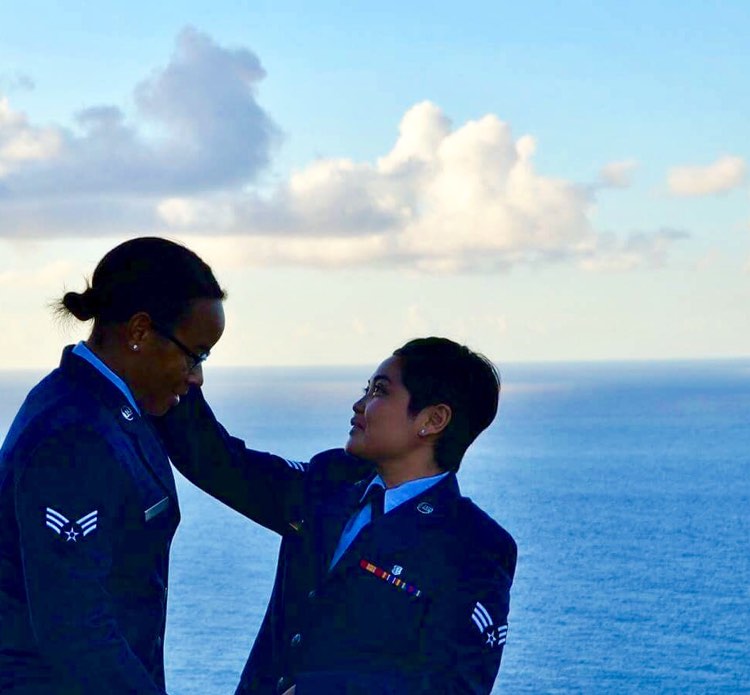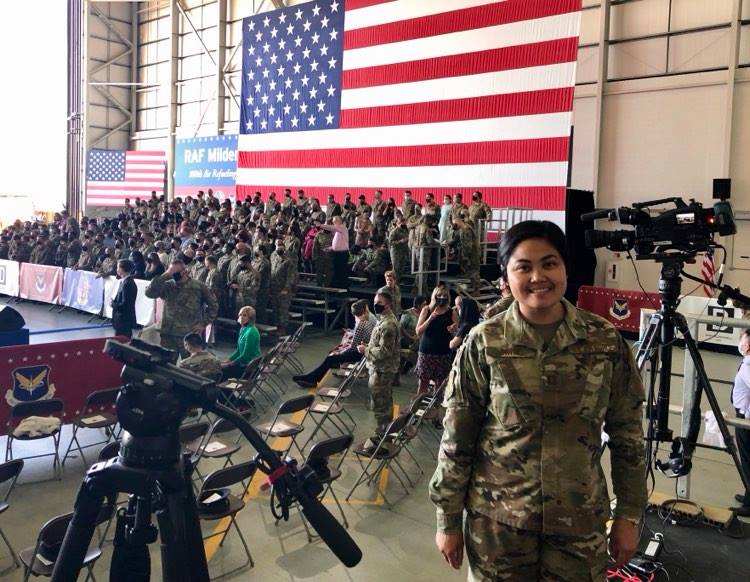By Emily Starbuck Gerson
When Captain Marie Ortiz joined the United States Air Force, her friends and family thought she’d lost her mind. She was around 30 years old and had a successful career in the Philippines, where she’d lived her entire life.
But Ortiz was thirsting for an adventure, and when an opportunity came to move to the United States, she took it and almost immediately made moves to join the military. She enlisted in 2014 and commissioned in 2016.
As a bisexual woman who grew up in a predominantly Catholic country, moving to America and serving with the Air Force did not just provide Ortiz with new experiences and broader perspectives — it allowed her to live as her truest self.
As an immigrant, however, Ortiz had to overcome some struggles. Between the language barrier, the different culture, and the new environment, fitting in was not as easy as she thought it would be. Learning to lead others with entirely different backgrounds was even harder. But she loves challenges as much as growth, and she has seen first-hand how diversity is both a strength and force multiplier.
Ortiz currently works in Public Affairs and is stationed with her wife at RAF Lakenheath in England, where she’s had even more exposure to new experiences and cultures.
Modern Military Association of America: When did you first begin identifying as bisexual, and what was your experience of coming out?
Marie Ortiz: I’d say it was when I started being attracted to girls. I was in high school at that time — an all-girls Catholic school, no less. As a kid, I would have boy crushes here and there. But during my adolescent years, a critical point in all of our lives as we explore our self-identities, I was in an environment surrounded by the same gender.
I honestly thought my same-gender attraction was just a phase, or me trying to follow a trend. Especially since later, in college, I dated a guy for six years. After that, I went on to date girls again, and I guess that’s when I really knew that I was bisexual.
Looking back, I don’t think there was a definitive moment of my coming out. It wasn’t an event or a point in time; it was more like bits and pieces throughout different chapters of my life. I remember quite vividly some remarks made by friends and family throughout my journey. Things like,“Are you with so and so? If you are, you better quit it right now — it’s foolish” or “It’s just a phase.” But I also heard things like, “I’ve always known that about you, and it’s perfectly alright, I still love you.”
It was an ongoing search and exploration of my identity, with a lot of internal back and forth, on a rollercoaster of self-denial and self-acceptance. One minute, I’m certain; the next, I’m in doubt. If I were to pick a “coming out story,” it would be my coming out to myself — when I stopped fighting my true identity and finally accepted who I am and who I love.
It was not easy. As the eldest in my family, I assumed a role from an early age of setting a good example and being a role model to my younger siblings and cousins. Being bisexual in a relatively traditional, conservative, and religious society was not exactly seen as being a good role model.
It was considered an abnormality, a sin. And that was my struggle. I wanted to be a responsible sister and daughter, but the then-society’s definition of “responsible” was not aligned with who I was. Finally coming around and accepting myself enabled me to live my truth, and it allowed me to see that true friends and my family are all there to support me.
MMAA: What has your experience been as an out LGBTQ service member?
MO: Nothing special, and that’s a good thing. Being an LGBTQ service member, I don’t feel like I’m different from anyone who is not. I feel like I belong.
I met my wife at a dental clinic in Andersen AFB in Guam, where we both worked as dental techs. Prior to getting married, my main concern was if we would face any issues as a same-sex couple in the military. Because although I was already comfortable with my identity and my family accepted and supported me, I didn’t know how it would be in an organization like the military. I know it’s accepted and supported on paper, but peoples’ mindsets and behaviors aren’t shaped just by policy.
I had asked LGBTQ military friends about their experiences, and they said that they hadn’t encountered anything negative or unfair so far. I knew the DOD was pushing some diversity and inclusion initiatives forward, and I’m thankful for that, but even if that wasn’t and isn’t the case, we would have still married — I just wanted to go in mentally prepared.
MMAA: And have you found acceptance thus far?
MO: Yes. Back in the Philippines, where I studied broadcast communication and worked in media earlier in my career prior to joining the military, I always felt accepted in my circle of friends who were broadcasters, journalists, musicians, filmmakers, writers, and artists. In my view and experience, most creative types are very fluid and accepting — I think maybe it just comes with the territory.
In the military, a totally different arena and structure, so far so good, especially in the public affairs unit I’m in now, where there are multiple LGBTQ members. It’s reassuring to see representation, and it’s nice to see Airmen living freely and truthfully.
MMAA: What drove you to enlist in the military, and what has been your experience as an immigrant and a Filipino serving in the US military?
MO: I crave experiences, adventures, continuous growth. Joining the military satisfied my curiosity about this unique lifestyle.
Migrating to the States was a big and drastic move for me, especially since I was already established in the Philippines. People asked why I was turning away from a deeply rooted, comfortable life just to join the military and start at the bottom when I was already successfully running my own business in the Philippines.
I get that most people would have probably chosen what’s familiar and comfortable and certain, but I also get that I am not most people, and that it’s perfectly fine with me. After all, conforming to traditions and fitting in molds has never really been my strong suit.
As a relatively older Filipino immigrant serving in the US military, I am able to observe more perceptively the differences and the similarities between the Filipino and American cultures. It allows me to float in between two different worlds, which is quite enriching and fascinating. I like how my different and unique set of experiences, insight, and background is appreciated in the military. I like how, even as I look different from most, that I am treated the same.
MMAA: When people questioned why you chose to immigrate and enlist, how did you answer?
MO: My simple answer was because I want to and because I can. For me, life is a collection of experiences, and this is another one I wanted to explore. One of my main drives, as shallow as it may be, was to experience the military bootcamp, which I have always been curious about. I jokingly tell people that I loved it so much I did it twice — once when I enlisted (BMT) and another one when I commissioned (OTS).
MMAA: Have you encountered any challenges as an immigrant within the military?
MO: My main challenge as an immigrant is relating to people from a totally separate and different culture and society. English is not my first language, and although I feel like I am fluent in it, assimilating information can be a challenge. For example, understanding slang or idiomatic expressions, which are used in formal and informal settings on the daily. It’s especially challenging since communication is at the core of my career field, public affairs.
MMAA: One topic that’s come up a lot in diversity-related discussions this past year is racism and hate crimes against the AAPI community. What has your experience been, and do you have thoughts on what the DOD can do to address it?
MO: My family and I haven’t been victims of hate crimes, fortunately, but who knows, it may just be a matter of time. The rising cases we see in the media is appalling! And I cannot honestly say that I do not worry about my family members who are in California, where a lot of reported hate crimes have taken place.
After all that the human race has been through, all the hate crimes witnessed and condemned, particularly in modern history both in the United States and abroad, it’s unbelievable to see how we seem to be back at square one. Coming from a third-world country, I view nations like the United States to signify progress and advancement. So it was a shock to me to see that in some areas, the US seems to lag behind, such as in gender and race equality.
As an immigrant, I had never seen so much inequality and hate until I moved to the US. One could argue that’s because I grew up in a more homogeneous environment, and that friction would naturally occur in a more diverse society. That may be true, which is why as a nation leading other nations, we Americans — white, Black, brown, old and young, leaders and citizens — should take it upon ourselves to show the world that diversity, differences, and peace can all co-exist. I think it starts with each one of us — to stand up and speak out against social and racial injustices. It also starts with the leaders — to lead and govern with fairness and equality.
Of course this is my own speculation, but through the concept of social proof, leaders’ rhetoric, and media stories published may have influenced the rise in hate crimes, so I think it’s important for leaders and the media to recognize and to use responsibly the power that lies in words and stories. I recently read an article detailing the different cases of hate crimes in California and New York, and nowhere in the article were the criminals mentioned. That may have been done on purpose, again in line with social proofing, but I personally would want to know what happened to the criminals and if justice has been served. I was thinking that strategically putting the spotlight on the consequences of criminal acts would deter the attacks.
Speaking of words and stories and how influential they are, I think the DOD is doing a great deal in its push to be more diverse and more inclusive. I see more and more stories now highlighting diversity and inclusion. Initiatives such as DAFBAWG, PACT, and WIT, among others, greatly help in the efforts to shape a more just culture within the DOD.
MMAA: Could you tell us more about these initiatives?
MO: The Pacific Islander and Asian American Community Team (PACT) is one of the Department of the Air Force Barrier Analysis Working Group (DAFBAWG) teams. It is an all-volunteer organization aligned under HAF/A1. Some members represent their organizational units in their assigned roles, while most are volunteers dedicated to identifying and addressing artificial barriers to Asian American and Pacific Islanders (AAPIs) in policies, processes, and programs. The Women’s Initiatives Team (WIT) is another DAFBAWG, and they’re doing similar work for the military’s female population.
Of course, more can be done and cultural shift is a continuous process, but I think the Department of Defense is on the right track.




